Tissue(s) present in an annual ring is/are
secondary xylem and phloem.
primary xylem and phloem.
secondary xylem only.
primary phloem and secondary xylem.
Correct Answer :
C. secondary xylem only.
The periodical activity of the cambium, thus results in distinct growth layers or rings of secondary xylem. These are called growth rings. The growth rings of spring wood and autumn wood produced in a year constitute an annual ring.
Related Questions
Tissue(s) present in an annual ring is/are
secondary xylem and phloem.
primary xylem and phloem.
secondary xylem only.
primary phloem and secondary xylem.
Identify types of vascular bundles in given figures A, B and C.
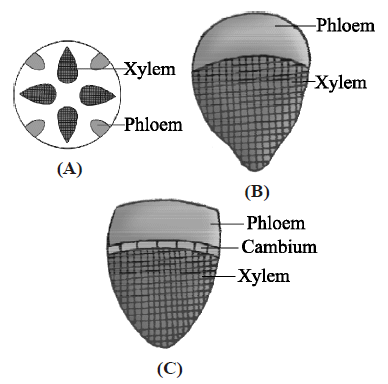
Radial; Conjoint closed; Conjoint open
Conjoint closed; Conjoint open; Radial
Conjoint open; Conjoint closed; Radial
Bicollateral; Concentric; Radial
The trees growing in desert will
show alternate rings of xylem and sclerenchyma.
have only conjunctive tissue and phloem is formed by the activity of cambium.
show distinct annual rings.
not show distinct annual rings.
In the given columns, column I contain structures of female reproductive system and column II contain its feature. Select the correct match.
| Column-I | Column-II |
|---|---|
| A. Lateral meristem | (i) Fascicular vascular cambium, interfascicular cambium and cork cambium. |
| B. Apical meristem | (ii) Produces dermal tissue, ground tissues and vascular tissue. |
| C. Bast fibres | (iii) Generally absent in primary phloem but found in secondary phloem. |
| D. Sap wood | (iv) Involved in the conduction of water and minerals from the root to leaf. |
A - (i), B - (ii), C - (iii), D - (iv)
A - (iii), B - (i), C - (ii), D - (iv)
A - (i), B - (iv), C - (iii), D - (ii)
A - (ii), B - (iv), C - (iii), D - (i)
Read the following statements and answer the question.
- Cambium is very active and produces a large number of xylary elements having vessels with wider cavities.
- It is also called early wood.
- It is lighter in colour and has lower density.
Which type of wood is described by the above statements?
Sap wood
Heart wood
Spring wood
Autumn wood
The apical meristem of the root is present
in all the roots.
only in radicals.
only in tap roots.
only in adventitious roots.
Identify the types of simple tissue indicated by A, B, C and D and their function.
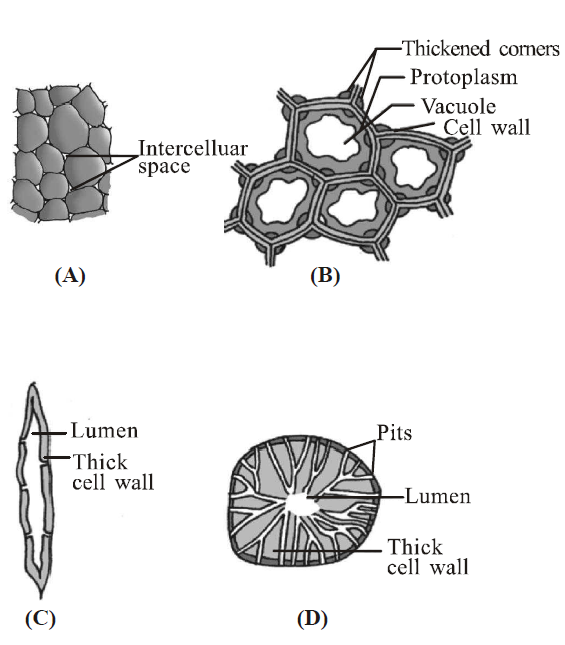
A Parenchyma, Photosynthesis, Storage and Secretion.
B Sclerenchyma Scleriods; Transport food material
C Collenchyma; Provides mechanical support to organs.
D Sclerenchyma Fibres; Provide Mechanical support to the growing parts of the plant such as young stem and petiole of a leaf.
Match the elements of xylem given in column I with their character given in the column II and choose the correct option.
| Column-I | Column-II |
|---|---|
| A. Xylem vessels | I. Store food materials |
| B. Xylem tracheids | II. Obliterated lumen |
| C. Xylem fibres | III. Perforated plates |
| D. Xylem parenchyma | IV. Chisel-like ends |
A IV; B III; C II; D I
A III; B II; C I; D IV
A II; B I; C IV; D III
A III; B IV; C II; D I
An organised and differentiated cellular structure having cytoplasm but no nucleus is called _________.
vessels
xylem parenchyma
sieve tubes
tracheids
Phellogen and phellem respectively denote
cork and cork cambium,
cork cambium and cork,
secondary cortex and cork,
cork and secondary cortex,
Why grafting is successful in dicots ?
In dicots vascular bundles are arranged in a ring.
Dicots have cambium for secondary growth.
In dicots vessels with elements are arranged end to end.
Cork cambium is present in dicots
Cells of permanent tissues are specialized
functionally.
only structurally.
both structurally and functionally.
for mitosis.
T.S. of dicot stem is given below, certain parts have been marked by alphabets (A I). Choose the option which shows their correct labelling.

A Epidermis, B Epidermal hair, C Parenchyma, D Starch sheath, E Hypodermis (collenchyma), F Vascular bundle, G Bundle cap, H Medulla or pith, I Medullary rays
A Epidermal hair, B Epidermis, C Hypodermis (collenchyma), D Parenchyma, E Endoderm is (Starch Sheath), F Pericycle, G Vascular bundle, H Medullary rays, I Medulla or pith
A Epidermal hair, B Epidermis, C Hypodermis (collenchyma), D Starch sheath, E Parenchyma, F Vascular bundle, G Bundle cap, H Medulla or pith, I Medullary rays
A Epidermal hair, B Epidermis, C Parenchyma, D Hypodermis (collenchyma), E Starch sheath, F Vascular bundle, G Bundle cap, H Medulla or pith, I Medullary rays
Tissues are classified into two main groups, namely meristematic and permanent tissues on the basis of
whether the cells being able to divide or not.
position of the cells.
whether they are living or dead.
none of the above
Which of the following is responsible for the formation of an embryonic shoot called axillary bud?
Lateral meristem
Apical meristem
Intercalary meristem
Both
Main function of lenticel is
transpiration
guttation
gaseous exchange
both (a) & (c)
A student was given a tissue to observe under the microscope. He observes the tissue and concludes that the tissue is a type of simple plant tissue and provides mechanical support to young stem and petiole of leaf.
Identify the tissue.
Parenchyma
Collenchyma
Sclerenchyma
Xylem parenchyma
As secondary growth proceeds, in a dicot stem, the thickness of
sapwood increases.
heartwood increase.
both sapwood and heartwood increases.
both sapwood and heartwood remains the same.
In stems, the protoxylem lies towards the _____________ and the metaxylem lies towards the ____________ of the organ.
centre; periphery
periphery; centre
periphery; periphery
centre; centre
Various functions like photosynthesis, storage, excretion performed by _____________.
sclerenchyma
parenchyma
collenchyma
aerenchyma
A plant tissue when stained showed the presence of hemicellulose and pectin in cells wall of its cells. The tissue is called
collenchyma
sclerenchyma
xylem
meristem
Which type of plant tissue is being described by the given statements?
- It consists of long, narrow cells with thick and lignified cell walls having a few or numerous pits.
- They are dead and without protoplasts.
- On the basis of variation in form, structure, origin and development, it may be either fibres or sclereids.
- It provides mechanical support to organs.
Parenchyma
Sclerenchyma
Collenchyma
Chlorenchyma
Which of the following pair of match is not correct?
Pith - Large and well developed in monocotyledonous root.
Root hairs - Helps in preventing water loss due to transpiration
Sieve tube elements - Its functions are controlled by the nucleus of companion cells.
Stomatal apparatus - Consists of stomatal aperture, guard cells and surrounding subsidiary cells
Which of following helps bamboo and grasses to elongate ?
Apical meristems
Lateral meristems
Secondary meristems
Intercalary meristems
The given figure shows T.S. of monocot stem. Identify the correct labelling of A to F marked in the given figure.
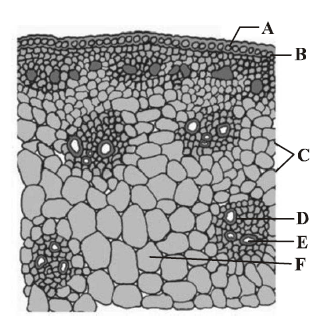
A Epidermis, B Hypodermis, C Vascular bundles, D Phloem, E Xylem, F Ground tissue
A Cuticle, B Epidermis, C Sclerenchymatous sheath, D Sclerenchymatous hypodermis, E Parenchymatous sheath, F Phloem
A Cuticle, B Epidermis, C Sclerenchymatous hypodermis, D Sclerenchymatous sheath, E Parenchymatous sheath, F Phloem
A Cuticle, B Epidermis, C Sclerenchymatous hypodermis, D Sclerenchymatous sheath, E Parenchymatous sheath, F Protoxylem
When we peel the skin of a potato tuber, we remove
periderm
epidermis
cuticle
leaves
Identify A, B and C in the given figure of shoot apical meristem
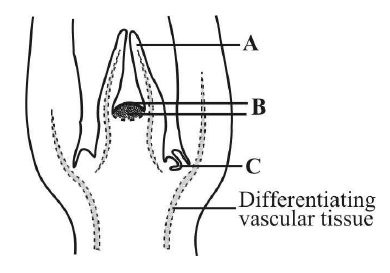
A Leaf primordium, B Shoot apical meristem, C Axillary bud
A Leaf primordium, B Shoot apical meristem, C Apical bud
A Root hair primordium, B Root apical meristem, C Axillary bud
A Root hair primordium, B Root apical meristem, C Terminal bud
Match the names of the structures given in column-I with the functions given in column-II, choose the answer which gives the correct combination of the two columns :
| Column-I | Column-II |
|---|---|
| (Structure) | (Function) |
| A. Stomata | I. Protection of stem |
| B. Bark | II. Plant movement |
| C. Cambium | III. Secondary growth |
| D. Cuticle | IV. Transpiration |
| V. Prevent the loss of water | ... |
A V, B III, C I, D IV
A I, B IV, C V, D III
A II, B IV, C I, D III
A IV, B I, C III, D V
Which of the following figure is a type of permanent tissue having many different types of cell?
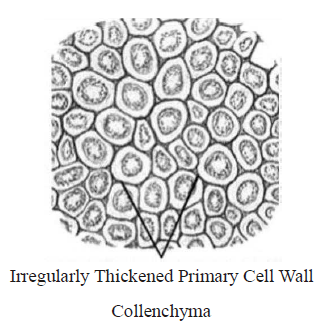
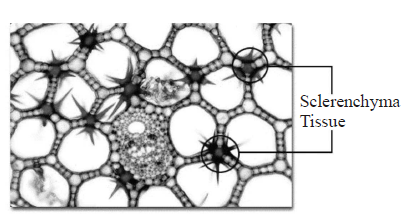
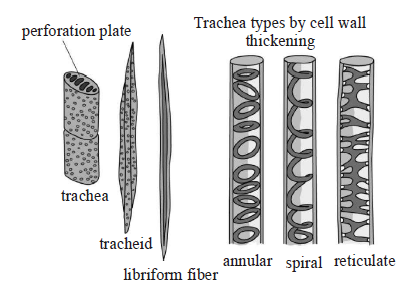
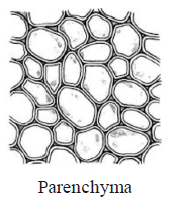
Cambium is considered as a lateral meristem because
it gives rise to lateral branches.
it causes increase in girth.
it increases height and diameter of a plant.
it adds bulk to a plant.
